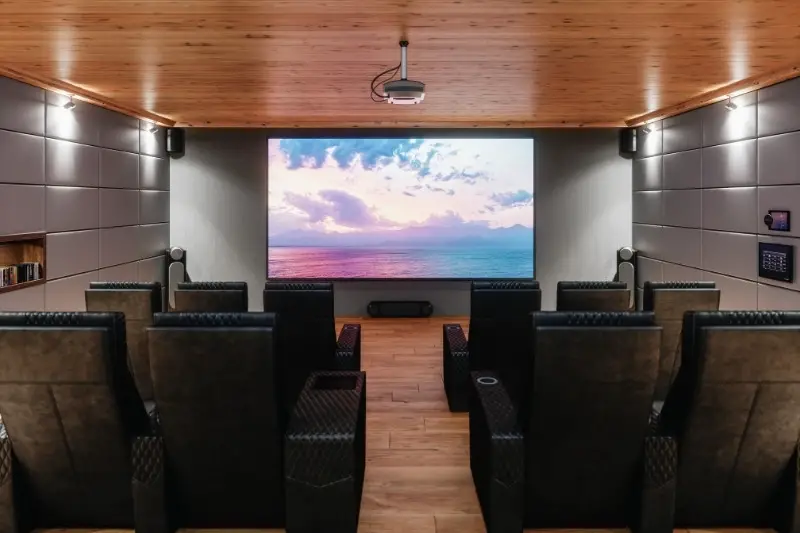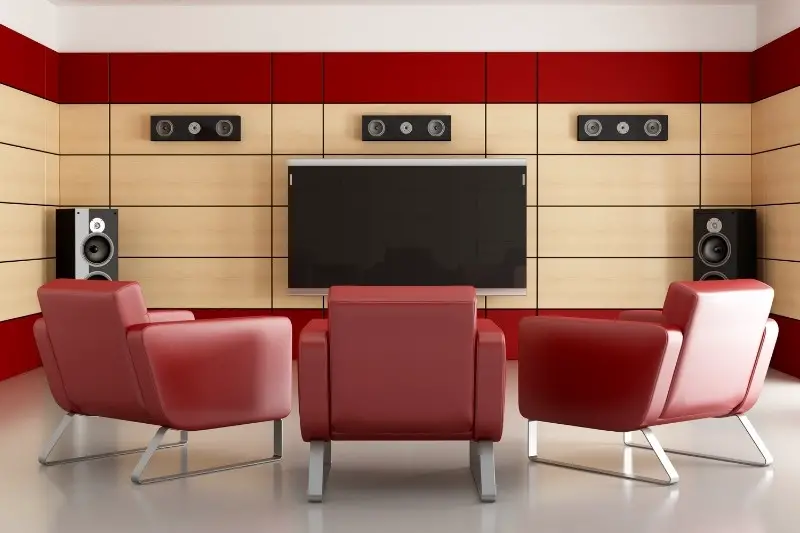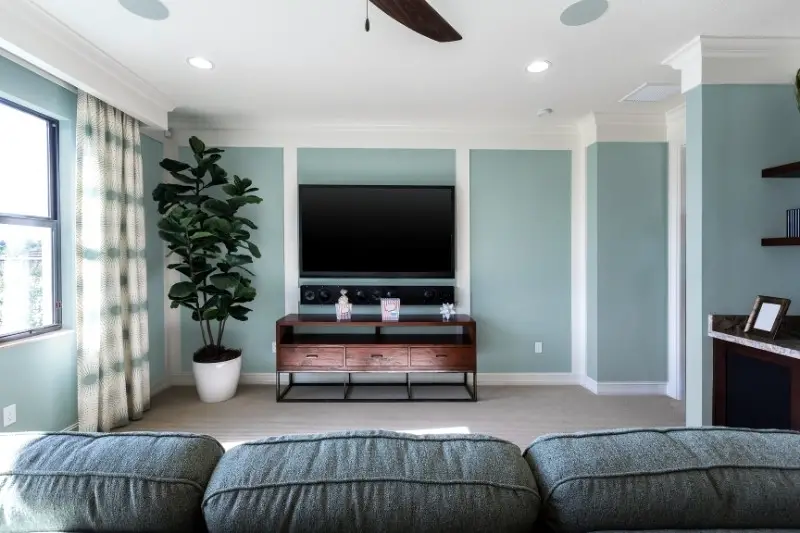Nobody can deny that watching a movie in a cinema with the latest surround sound system, (which cinemas around the world care a lot to offer) is a very pleasant experience, and that’s precisely the reason why so many manufacturers compete to offer an equivalent version for people to enjoy movies at home and get the same excitement.
Although we can currently enjoy video images at 4K UHD and several versions of surround sound systems, many people still don’t know which of these surround options is the best for the space they want to set as their home theater room. So, let’s begin with 7.1:
7.1 is a surround system that needs 7 channels of audio plus an extra channel for low frequencies (50 kHz – 200 kHz). It’s better experienced in rooms at least 375 ft2 or 3750 ft3. Place the rear speakers at the level of your ears and at least 5 feet away from you. The front speakers are meant to be 40-45° towards you, and about 10 feet away.
It’s so frustrating to find out that so many websites omit to mention what’s the right sound system to get the best experience at home and, as a trained audio engineer, I can tell that we work really hard in the studio to provide all users with the very best sound for each product (movies, TV, radio, audiobooks, video games).
My purpose in this article is to guide you to get the best experience possible when using a 7.1 surround sound system, as well as different sets of speakers, headsets, and headphones. So, let’s begin with:
- What Room Area Is Best for a 7.1 Home Theater System
- Things to Keep in Mind When Choosing a 7.1 Surround Sound System
- Wired speakers vs wireless speakers
- What Is the Best Audio System for Your Room Size
- Pros and Cons of Stereo, 7.1, 5.1
- 7.1 Audio System vs Stereo
- 7.1 Speakers vs Stereo Speakers
- What Is the Difference Between Powered and Unpowered Speakers
- What Is the Difference Between 2-Way and 3-Way Speaker Systems
What Room Area Is Best for a 7.1 Home Theater System
For an area of at least 3800 cubic feet or more, a 7.1 surround sound system will provide an outstanding experience. Whether the room has a square or a rectangle shape, this minimum area allows the user to listen to sound effects and music as realistically and dramatically as in a large cinema or game room.
Here are some sample images of the room area of a 7.1 home theater system in several rooms and shapes.



Things to Keep in Mind When Choosing a 7.1 Surround Sound System
Wired speakers vs wireless speakers
If you get a wireless system (Bluetooth speakers), bear in mind that each speaker is not going to sound as loud as a wired speaker, but will sound good enough. Also, the higher the sound level you want, the higher the price of the audio system will be.
- Unwanted hiss noise: Depending on the manufacturer, sometimes rear wireless speakers make a soft hiss sound, caused by the battery system providing energy to the tweeter (high-frequency sounds) and bass (low-frequency sounds) cones.
- That might bit a little bit annoying when you are watching a very quiet moment in a movie (if you’re a sound purist, like me!) or when listening to quiet parts in music available for surround sound systems. But most people don’t even notice it.
- Wired speakers are going to provide higher volume levels. This implies using wall cord covers or large carpets, to hide the cables and make them safe, so no one in the home theater room will trip with them.
- If you are patient and think that you can handle the job, go for it and install all the speakers by yourself.
- If you think it will be rather annoying or time-wasting, hire someone to do it for you, although you will have to pay a fee ($75 – $100 without materials).
- Avoid having hard reflective walls in your home theater room. Choose absorbing materials like acoustic foam panels and place them in the spots where you notice the sound is not very pleasant.
You can notice these unwanted noises when the glasses of your windows or any other elements on shelves or other surfaces start to vibrate and eventually move or fall.
What Is the Best Audio System for Your Room Size
The easiest rule to choose the best audio system for your room size is the larger the room, the more channels the surround system needs. The average area range for 7.1 systems starts at 2,000 cubic feet and more. Rooms up to 1,000 cubic feet are perfect for 5.1 systems. Small areas can do really well with 2.1 systems.
Let’s see more details about recommended systems according to the available area:
| Room Area and Suggested Viewing Distance | Surround Sound System | Best Options | Manufacturers and Prices(2022) |
| 7,000 cubic feet and more and 20 feet viewing distance | 7.1 | For 2 – 3 rows of seating | LG SN11RG 770W 7.1.4-Channel Soundbar System$1296.99 |
| 3,000 cubic feet and 12 feet viewing distance | 7.1 | For 1 row of seating | Nakamichi Shockwafe Pro 7.1 SSE 600W Soundbar System $750 |
| 2,000 cubic feet and 8 feet viewing distance | 7.1 | For 1 row of seating | Denon AVR-S750H Receiver, 7.2 Channel $ 684.99 |
| 1,000 cubic feet and 7 feet viewing distance (or as desired) | 5.1 | For 1 row of seating | Logitech Z906 5.1 Surround Sound Speaker System$299.99 |
| 35 – 50 square feet open home office3 – 4 feet viewing distance | 2.1 | 1 front seating | Harman Kardon SoundSticks 4 Bluetooth Wireless 2.1 Speaker System$299.95 |
Pros and Cons of 7.1, 5.1, 2.1, and Stereo
The main pros of 7.1, 5.1, and 2.1 are a great stereo picture (like in stereo systems) for the room size they were designed for, and a powerful effect with the subwoofer’s low frequencies (the .1 big speaker). The most common cons are poor setting up instructions and extra expenses for additional accessories.
Pros of 7.1, 5.1, 2.1, and Stereo
- Both 7.1 and 5.1 can use a front soundbar rather than the left, center, and right speakers.
- 2.1 systems offer a pair of tweet speakers and a subwoofer big speaker meant to be placed to one side of the stereo picture (left or right is just your personal choice). This allows manufacturers to offer a low price for a satisfactory listening experience.
- A pair of stereo speakers contain both types of cones: tweets for middle and high frequencies, and a much larger cone for low frequencies. This is the cheapest option and it’s usually chosen to listen to music or radio programs.
A stereo picture means the perception that sound moves from one side to the other or that it comes from a specific place in the picture.
Even a basic pair of stereo speakers help you experience how the characters, musicians, or elements in a movie, a video game, or a music concert move.
- Soundbars do a good job to reproduce the original stereo picture created by sound designers and audio engineers and save time for setting up the front, left, and right speakers.
Most brands offer a side-firing effect (sound goes up, down and to the sides) that makes you feel you’re immersed and surrounded by the elements of the sound effects and the setting presented in the story, and that feels really cool!
Cons of 7.1, 5.1, 2.1, and Stereo
- The prices of 7.1 and 5.1 surround systems can go higher than $1,000 as most of the brands offer a wireless system: the more sophisticated the technology is, the higher the price.
- It’s common to hear people complain about the front or rear speakers, as manufacturers do not always state that it may be necessary to mount them on sound-absorbing columns. The issue is that on many occasions those accessories are not included.
- The speakers may also need to be placed on an acoustic piece of foam and all of these unexpected extra features end up increasing the original budget, leaving a bitter-sweet flavor at the time of setting up a home theater system for the first time.
7.1 Audio System vs Stereo
7.1 is a perfect surround format for movies, AAA video games, or music concerts, in a large room (3750 cubic feet or more, 1 – 3 rows of seating). Stereo hi-fi or 2.1 systems are a good choice for small spaces like a home office or areas where people listen to audiobooks, podcasts, live radio, AA, or more basic video games.
To this point, it can be completely clear that surround systems like 7.1 and 5.1 are the best choice for home theater rooms.
The thing is that when it comes to audiobooks, podcasts, live digital or analog radio, or video games that don’t feature surround sound effects, the surround speakers and subwoofer are going to be doing nothing. Why is that?
As the sound of human speech is in the middle and high-frequency range, we can easily notice that the sound of their voices comes from the front speakers, not the subwoofer nor the rear speakers, in both a cinema or in a medium/large home theater system.
Nevertheless, there might be sound effects of far voices approaching from a different direction than the left, center, and right positions, therefore, we can hear them come from the rear speakers.
Here is when a stereo hi-fi, a 2.1 stereo system, or even a portable speaker can do an excellent job, as well. The following aspects are useful when making a decision of purchasing a sound system for speech or music only.
- Both 7.1 and stereo systems provide a good stereo picture. For speech and music, the sound will come only from the front speakers or soundbar.
- 7.1 and 5.1 need a large subwoofer speaker. A soundbar can provide some bass sound but is not even ⅕ of the sound provided by a subwoofer.
- Stereo speakers (also called Hi-Fi) contain 2 or 3 types of cones: small tweets for middle and high frequencies, and a large subwoofer for low frequencies.
- A 7.1 system is great for 2,000 + cubic feet rooms
- Stereo systems are a good choice for a home office or a room destined to enjoy music, audiobooks, or radio programs.
To enjoy the best of stereo and 2.1 sound systems it’s necessary to place the speakers at the right distance and with a certain position towards the listener’s ears. A correct setup provides a nice perception of location or movement left, center, right.
7.1 Speakers vs Stereo Speakers
7.1 speakers in surround systems play middle and high frequency sounds through small cones and bass frequencies with large woofer cones. A standard stereo speaker has both types of cones. Some stereo models (2.1 systems) offer left and right small cone speakers plus a large cone woofer speaker.
Let’s take a look at the differences between different types of stereo speakers in the next section.
What Is the Difference Between Powered and Unpowered Speakers
When the speakers need to be wired to the amp unit (radio tuner, CD/MP3 player, USB input, and Auxiliary input) they are unpowered speakers. Powered speakers have a built-in amplifier and need to be connected or charged to an AC adaptor. They play sound from Bluetooth, Auxiliary (mini-jack stereo), or USB inputs.
- Professional powered speakers are also called studio monitors. They have a volume knob at the back of one of the speakers, which is necessary to keep at zero level every time you turn them on and before you turn them off.
- They can also have a second knob to select how loud you want the bass sounds. You’re free to choose how loud you want them to sound, but always keep in mind listening to safe levels: never more than 85 dB, under 65 dB if possible.
What Is the Difference Between 2-Way and 3-Way Speaker Systems?
In simple terms, a 2-way system has a large woofer driver (a large cone shape piece, also called horn) for low or mid frequencies and a small tweeter for high frequencies (small cone). A 3-way system features the same woofer and tweet cones but includes an additional one only for high frequencies.
